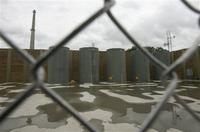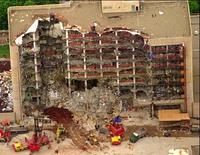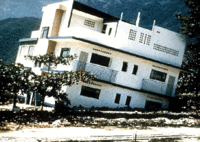-
California school building regulators had ties with anti-regulation lobby group
A California watchdog group recently revealed that state officials in charge of enforcing earthquake standards for school buildings have had a long and questionable relationship with a lobbying group that actively works to oppose building safety regulations in public schools; senior officials with the Division of the State Architect had been dues paying members of the Coalition for Adequate School Housing, which actively lobbies for less regulation on school construction; in 1997, state regulators were told that taxpayers would reimburse their membership dues to be a part of the lobbying group; officials maintain that there has been no corruption; in 2010 a major regulatory provision in place since 1933 was removed
-
-
New guide explains perimeter protection options
A new guide explains the subject of perimeter protection clearly and concisely to enable specifiers, facilities managers, security managers, and consultants to identify the optimum security measures for particular premises and threats; it covers not only high-security fencing, barriers, and gates, but also electric pulse systems and associated security measures such as access controls, CCTV, and intrusion detection systems
-
-
PG&E send safety information to customers living near gas pipelines
PG&E begins notifying customers of gas transmission pipeline locations and highlights actions the company is taking to make natural gas transmission lines safer; the letter safety brochures is being to 2.5 million homeowners and businesses located within about 2,000 feet of a natural gas transmission pipeline
-
-
Recycled concrete saves money
Purdue University civil engineers are working with the Indiana Department of Transportation to perfect the use of recycled concrete for highway construction, a strategy that could reduce material costs by as much as 20 percent; “If you are going to pave, you may have to remove the old concrete and break it into pieces anyway, so recycling makes sense,” one of the researchers says
-
-
Wyoming braces for spring floods
The Wyoming Office of Homeland Security is readying local and state agencies for projected spring floods and is urging local residents to prepare themselves as well; this year large snow packs from heavy winter storms have increased the likelihood of flooding; state officials are encouraging families to keep a three-day emergency kit loaded with food, water, clothing, flashlights, medicine, and important documents; last year floods hit Wyoming causing major disruptions, particularly in Fremont County; this year state officials hope to minimize the impact of floods with early preparation
-
-
Cooling pools or dry casks for nuclear waste: which is safer

There are two ways to store nuclear waste: in pools of water, where the densely packed uranium rods are cooled by a constant flow of circulating water, or in dry casks — typically barrel-shaped steel-and-concrete structures that stand twenty feet high and sit outdoors — where the uranium loosely packed rods are cooled by passive air; there are 65,000 tons of nuclear waste in the United States, more than in any other nation, and this amount grows by about 2,200 tons each year; the Fukushima disaster demonstrated that dry casks were able to withstand the 11 March combination of earthquake and tsunami much better than cooling pools; the U.S. Nuclear Regulatory Commission must now decide whether cooling pools are safe enough to store nuclear waste, and even whether densely packing nuclear waste is safe
-
-
Chernobyl radiation did not damage abundance, diversity of aquatic life
A new study of the lakes in and around Chernobyl’s fallout zone reveals that radiation from the nuclear accident appears to have had no long term effect on the abundance or diversity of aquatic animal life; no evidence was found that the abundance or diversity of the animal communities was influenced by direct contamination from the Chernobyl accident; indeed, the most contaminated lake, Glubokoye, 6.5 km north of the nuclear power plant, supported the most animal diversity of those lakes studied
-
-
Dramatic increase in critical infrastructure cyber attacks, sabotage
A new study by McAfee and CSIS reveals a dramatic increase in cyber attacks on critical infrastructure such as power grids, oil, gas, and water; the study also shows that that many of the world’s critical infrastructures lacked protection of their computer networks, and revealed the staggering cost and impact of cyberattacks on these networks
-
-
Secret bomb-proofing building design posted on the Web

The Pentagon is building two towers in Alexandria, Virginia, to house 6,400 personnel; the Army Corps of Engineers inadvertently posted the bomb-proofing specifications for the new buildings on the Web; experts say this will allow terrorist to learn how to circumvent the building defenses; there is another problem; the documents reveal that the specifications call for the building to be designed to resist threats posed by vehicle bombs detonated outside the building’s security perimeter carrying the equivalent of 220 pounds of TNT; experts say this is not enough; Timothy McVeigh used 4,000 pounds of TNT in Oklahoma City in 1995; the 1993 attempt on the World Trade Center involved 900 pounds; the attack on the Marine barracks in Lebanon in 1983 involved 12,000 pounds of TNT
-
-
Lessons from Japan's tsunami could dramatically shift building codes
American tsunami experts and engineers are scouring the devastation wrought by the 11 March earthquake and tsunami to analyze how structures fared during the natural disasters and what lessons can be applied to U.S. building codes; experts are particularly concerned about the toppling of a reinforced-concrete building as that has been the baseline for tsunami construction and evacuation procedures; experts were stunned by the devastation and are concerned about America’s West Coast which is significantly less prepared than Japan for an earthquake or tsunami; in particular experts are concerned about Oregon which shares many geological similarities to Japan’s northeastern coast; researchers hope to learn valuable lessons that will minimize the destruction from a similar event in the United States
-
-
Much of earthquake damage in Japan caused by "liquefaction"

The massive subduction zone earthquake in Japan caused a significant level of soil “liquefaction” that has surprised researchers with its widespread severity, a new analysis shows; the findings also raise questions about whether existing building codes and engineering technologies are adequately accounting for this phenomenon in other vulnerable locations, which in the United States include Portland, Oregon, parts of the Willamette Valley, and other areas of Oregon, Washington, and California
-
-
Robot reports high radiation inside crippled reactors
A U.S.-made robot traveled inside Unit 1 and Unit 3 of the crippled Fukushima plant, and came back with radioactivity readings of up to 49 millisieverts per hour inside Unit 1 and up to 57 millisieverts per hour inside Unit 3; the legal limit for nuclear workers was more than doubled since the crisis began to 250 millisieverts; the U.S. Environmental Protection Agency recommends an evacuation after an incident releases 10 millisieverts of radiation, and workers in the U.S. nuclear industry are allowed an upper limit of 50 millisieverts per year
-
-
Sector Report for Monday, 18 April 2011: Infrastructure protection
This report contains the following stories.
Plus 2 additional stories
-
-
Strong fabric can be used to protect buildings from explosion
Carbon fiber reinforced polymer (CFRP) is a fabric that can carry 143,000 pounds of force per square inch; University of Missouri researcher collaborates with the U.S. Army to test a method of retrofitting buildings to protect them in the case of a terrorist attack; to protect a building from an extreme event, CFRP can be used to increase the bending capacity of walls or columns
-
-
Siemens, McAfee team up to defend against critical infrastructure attacks
McAfee and Siemens will work together to help secure critical infrastructure against cyber attacks that target industrial control processes like the Stuxnet worm which destroyed nuclear centrifuges at an Iranian nuclear enrichment facility; the two companies are targeting Advanced Persistent Threats aimed at the manufacturing and process industry; this new security product could help ease security fears for critical infrastructure operators who rely on industrial control programs for nearly every automated process; McAfee says it’s Application Control system product would have protected Iran’s centrifuges from the Stuxnet virus that caused them to spin out of control
-
- All
- Regional
- Water
- Biometrics
- Borders/Immig
- Business
- Cybersecurity
- Detection
- Disasters
- Government
- Infrastructure
- International
- Public health
- Public Safety
- Communication interoperabillity
- Emergency services
- Emergency medical services
- Fire
- First response
- IEDs
- Law Enforcement
- Law Enforcement Technology
- Military technology
- Nonlethal weapons
- Nuclear weapons
- Personal protection equipment
- Police
- Notification /alert systems
- Situational awareness
- Weapons systems
- Sci-Tech
- Sector Reports
- Surveillance
- Transportation
Advertising & Marketing: advertise@newswirepubs.com
Editorial: editor@newswirepubs.com
General: info@newswirepubs.com
2010-2011 © News Wire Publications, LLC News Wire Publications, LLC
220 Old Country Road | Suite 200 | Mineola | New York | 11501
Permissions and Policies
Editorial: editor@newswirepubs.com
General: info@newswirepubs.com
2010-2011 © News Wire Publications, LLC News Wire Publications, LLC
220 Old Country Road | Suite 200 | Mineola | New York | 11501
Permissions and Policies
